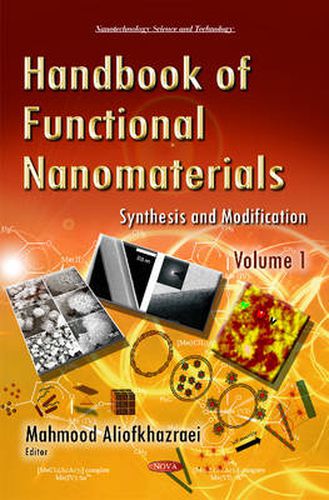Readings Newsletter
Become a Readings Member to make your shopping experience even easier.
Sign in or sign up for free!
You’re not far away from qualifying for FREE standard shipping within Australia
You’ve qualified for FREE standard shipping within Australia
The cart is loading…






This is the first volume of the four volume set of Handbook of Functional Nanomaterials. Functional nanomaterials appear in our daily lives. These materials mainly include nanocomposites, nanopowders, nanoparticles and nanocoatings. Nanotechnology enables the creation of structures that do not exist in nature, those which cannot be produced by conventional chemistry. Some advantages of this technology are the synthesis of stronger, more adjustable materials as well as lower costs. Nanotechnology is scientific and research development at the atomic, molecular, or macromolecular levels in a dimension range of 1 to 100 nm; the fabrication and application of the structures, equipment, and systems which involve unique characteristics and new applications because of their small or medium dimensions; and the potential for (materials and processes) and control and management of atomic scales. Due to the developed properties of the very fine powders including surface chemistry, compressive properties, optical characteristics, and synthetic reactions, as well as an increasing demand for fine powders in industries, a very fine fragmentation is applied in many materials such as: minerals, ceramics, dyes, chemicals, microorganisms, pharmaceuticals and paper manufacturing. This volume mainly discusses the synthesis and modification of functional nanomaterials. Some of the functional nanomaterials discussed in this volume are zinc oxide nanoparticles, iron oxide, cadmium chalcogenide nanoparticles, chitosan-based nanocomposites, mesoporous materials, gallium nitride nanowires, titania nanoparticles, plasmonic nanofilms, polyaniline nanocomposites and nano silver. There are 19 chapters in this volume; each one includes examples of these interesting materials, supported by appropriate figures for better clarification.
$9.00 standard shipping within Australia
FREE standard shipping within Australia for orders over $100.00
Express & International shipping calculated at checkout
This is the first volume of the four volume set of Handbook of Functional Nanomaterials. Functional nanomaterials appear in our daily lives. These materials mainly include nanocomposites, nanopowders, nanoparticles and nanocoatings. Nanotechnology enables the creation of structures that do not exist in nature, those which cannot be produced by conventional chemistry. Some advantages of this technology are the synthesis of stronger, more adjustable materials as well as lower costs. Nanotechnology is scientific and research development at the atomic, molecular, or macromolecular levels in a dimension range of 1 to 100 nm; the fabrication and application of the structures, equipment, and systems which involve unique characteristics and new applications because of their small or medium dimensions; and the potential for (materials and processes) and control and management of atomic scales. Due to the developed properties of the very fine powders including surface chemistry, compressive properties, optical characteristics, and synthetic reactions, as well as an increasing demand for fine powders in industries, a very fine fragmentation is applied in many materials such as: minerals, ceramics, dyes, chemicals, microorganisms, pharmaceuticals and paper manufacturing. This volume mainly discusses the synthesis and modification of functional nanomaterials. Some of the functional nanomaterials discussed in this volume are zinc oxide nanoparticles, iron oxide, cadmium chalcogenide nanoparticles, chitosan-based nanocomposites, mesoporous materials, gallium nitride nanowires, titania nanoparticles, plasmonic nanofilms, polyaniline nanocomposites and nano silver. There are 19 chapters in this volume; each one includes examples of these interesting materials, supported by appropriate figures for better clarification.